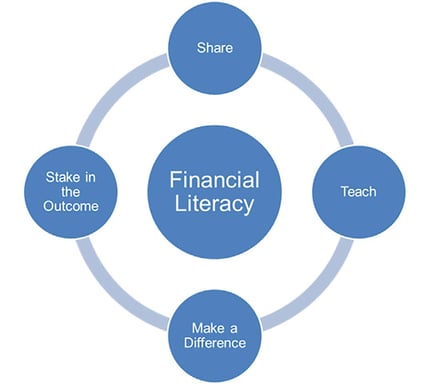What is an effective way of developing a sense of ownership?
Over the years, I have talked to several business owners who want their employees to think and act like owners. They want them to be engaged and passionate about their jobs and the workplace culture. They want them to enjoy coming to work. Workplace culture in an employee-owned company should come easily, right? These owners often see setting up an ESOP as a way to change the organization’s culture and instill the aforementioned traits of thinking and acting like an owner.
Two or three years later, I talk to some of the same owners, who once saw the ESOP as a cure for their cultural problems and now blame the ESOP and the employees for their inability to create an ownership culture.
They say: “I started this ESOP thinking that it would make all my employees care about their jobs. The dream of an ESOP ownership culture hasn’t done anything. In fact, their behavior is worse now.”
One would ask: “Why is it worse?” The answer is that these owners were using leadership to manage employees before the ESOP, and after the ESOP, they quit leading and managing them at all because they thought the ESOP would do this for them. I’ve heard of several cases like this.
So, if the ESOP is not going to be the magic potion, what is?
Taking the time to build your workplace culture is the key. I’m going to share with you a method using open-book management principles to help you create an entire organization of owners who lives ownership as a core value!
This model teaches your employees  about how a business works by teaching them the financials and how they are influenced by employees’ contributions. These steps will need to be implemented to maximize the potential of this process.
about how a business works by teaching them the financials and how they are influenced by employees’ contributions. These steps will need to be implemented to maximize the potential of this process.
How Can Financial Literacy Create a Culture of Ownership and Accountability?
The one thing that usually separates owners from employees is that most owners know how the business works. They understand the profit and loss (P&L), balance sheet, and cash flow statements. They know what the current ratio and the debt-to-equity ratios mean. They know how accounts receivable and inventory affect cash.
On the other hand, most employees have no idea what any of this means. They also don’t have any idea how they can influence all the numbers and percentages. So when they don’t understand something, what do they do? They make something up based purely on perception.
Most employees think the owners put about 50 percent of all revenue into their pockets. That’s 50 percent net, after all, expenses and taxes. If you don’t believe this, survey your employees. They think they are doing all the work, and the owner keeps all the profit. It’s all based on perception. Demystifying the business is a good way to start getting your employees to think like owners and begin taking ownership at work.
Share
How do you demonstrate ownership at work? It all starts with sharing information. The information includes the P&L statement, the balance sheet, and the cash flow statement. It also could include reports broken down from the P&L, such as COGS variances or expense line items.
Several owners and leaders have concerns about doing this. They worry about the competition seeing this information, but most of all, they worry about their employees seeing them.
As far as the competition goes, these reports are the news—they report on things that have already happened. These reports don’t tell competitors how your organization accomplished the things it did, and they don’t offer a glimpse into matching your culture.
As for employees, they are much smarter than you give them credit for. If you share only good news, they will think you are full of it. They understand that business is like life: Bad things happen. Nothing is great all of the time. Also, if you are not transparent, they will make up something. Remember, they think organizations net 50 percent after taxes.
Being transparent with your financial statements and metrics is vital in building trust. Don’t withhold bad information. Give them the Clint Eastwood version: The Good, The Bad, and The Ugly.

Teach
Sharing financials without teaching doesn’t work. It is important that employees understand each line item and how those line items connect to the organization’s performance. Most importantly, help employees understand how their actions affect each line item.
Start by creating courses that teach financials. Use tools in your training that relate to employees’ daily lives, like balancing a checkbook or calculating their net worth. Teach them exactly what the organization’s net income after tax really is. It is probably more like 6-10 percent rather than 50 percent.
To sustain the training, get employees involved. Have them lead meetings where they review the financial statements. Give them line item responsibility for expenses over which they have control. For example, let the office administrators have responsibility for office supplies on the expense line and have them forecast and report the actuals each month. Take every opportunity to teach, teach, and teach; it will begin developing ownership skills in the organization.
Make a Difference
Making a difference refers simply to allowing your employees to make decisions. How do you demonstrate ownership and accountability when you aren't allowed to do this? Yes, it’s true—they are going to make wrong decisions from time to time.
Owners make wrong decisions too.
When you give employees a sense of ownership through decision-making, they often want to be successful—and they will be. Don’t let two wrong decisions overshadow 50 right ones. The bottom line is people don’t wake up in the morning and say, “I’m really gonna suck at work today!” People want to succeed. It’s human nature.
Stake in the Outcome
This is where the ESOP is part of the equation. If you want everything to work according to this plan, there must be some reward for a job done well—and some form of detriment if objectives are unmet. This sounds very much like the risks the owner of an organization has! Don’t underestimate the power of this. It validates employees’ work and makes them part of the business.
Giving people a stake in the outcome can be done in a variety of ways, such as bonuses, commissions, profit sharing, and—my favorite—an ESOP. The reason I like the ESOP so much is that you are actually giving equity to the employees. For all other forms, make sure you tie their objectives to the decisions they make. They can make a difference! What they do matters!
Conclusion
Hopefully, this helps solve some of the issues regarding getting employees to act like owners. This will, in turn, help create and sustain an ownership culture in your organization. Employee ownership benefits the employee and the employer in so many ways. Not only is it a great tool to help your employees build wealth for themselves, but employee ownership is also a great tool in helping the organization attract and recruit talent.
Let’s go through the steps again.
- Share the financials and other data with employees. The P&L, balance sheet, cash flow statement, etc.
- Teach them the business using financial literacy as the tool.
- Give them the authority to make decisions. Use the wrong decisions to teach. Trust me; they will want to learn.
- Consider setting up an ESOP. This actually makes them employee-owners. Even though you may have an ESOP, you can still incorporate bonuses, profit sharing, prizes, etc.
This approach will take time and effort to implement and sustain. You have to be intentional about it. All your leadership must buy into this first. There will be bad and good days. Hang on. This sounds exactly like what an owner goes through. Exactly!
I am 100 percent certain that if I talked to all the owners who have successfully created and sustained an ownership culture, they would say it was worth the effort. I’m also 100 percent certain the employees would say the same thing.
This article, "Ownership Advantage: Financial Literacy is Key to Creating an Ownership Culture," was originally published in the September 2019 Issue of the The ESOP Report and republished with permission of the ESOP Association.
Learn more about establishing an ownership culture within your organization from practitioners just like you at The Great Game of Business Conference—the world's largest conference on open-book management.
.png)








.png)




-5.png)

